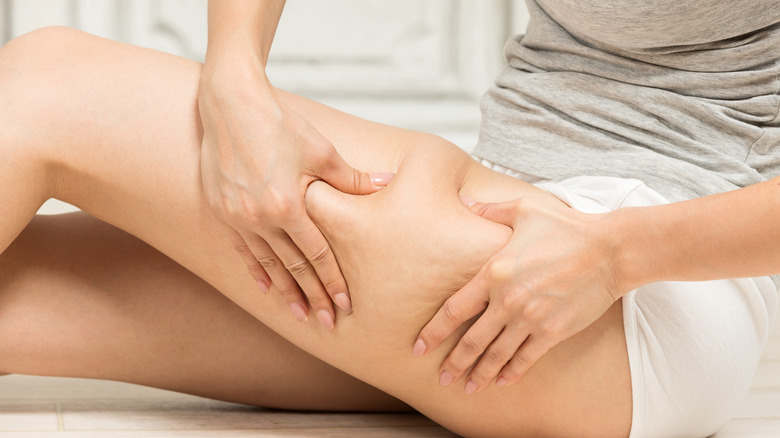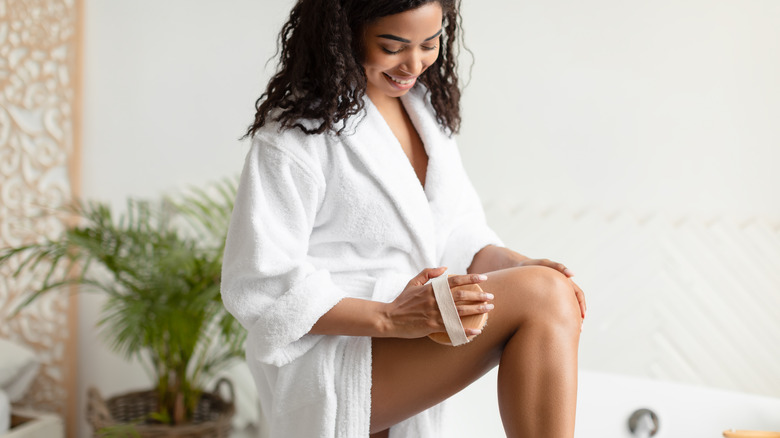Can Dry Brushing Really Help Get Rid Of Cellulite?
Leg dimples, cottage-cheese skin, hail damage — no matter what you choose to call cellulite, there's a good chance you have it somewhere on your body. In fact, between 80% and 90% of adult women do, according to Cleveland Clinic. This rippled, bumpy skin is caused by fat pushing on connective tissue beneath the skin's surface, and it's most commonly seen on the thighs, hips, buttocks, and midsection (per Mayo Clinic).
Cellulite is normal and completely harmless. However, it may be a source of insecurity for some women, especially when it appears on skin that's regularly exposed, like the upper arms. If you're struggling with a lumpy, bumpy texture, the bad news is that cellulite can't be fully erased once it appears. The good news is that some lifestyle changes and clinical treatments can reduce the appearance of unwanted dimples. Dry brushing is another solution for smoother skin that can be done at home in a pinch. Here's what to know before you try brushing away your cellulite.
Dry brushing may temporarily reduce cellulite
The most effective cellulite treatments often require lasers, needles, and repeated visits to your doctor, as the American Academy of Dermatology Association explains. Dry brushing, on the other hand, is a non-invasive, DIY option almost anyone can do from the comfort of their bathroom — and experts claim that it really works, at least to some extent.
Dr. Michele Green, a dermatologist, shared with Byrdie, "Having increased circulation from dry brushing will cause vasodilation (that's when your capillaries widen, causing an increased amount of blood flow in the area). [...] This will cause a temporary plumping up of the skin, making your cellulite appear less visible." Note the word "temporary" — results likely won't be permanent. Still, some dry brushing enthusiasts argue that scrubbing away at the skin is an effective way to change its texture from the inside out. "Even gentle brushing brings nutrient-rich freshly oxygenated blood to the skin's surface, which gives it a better tone and elasticity," Kate Shapland, founder of health brand Legology, told Elle.
However, not everyone is as quick to recommend the technique. "[Dry brushing] does exfoliate, which is fine if not done too vigorously," Dr. Carolyn Jacobs, a dermatologist and director at Chicago Cosmetic Surgery and Dermatology, said to Healthline. "But it won't help cellulite as that is due to fat and collagen bands in women."
How to dry brush your way to smoother skin
Dry brushing may not be a miracle treatment for stubborn cellulite, but it could plump the skin temporarily before, say, a photo shoot or day at the beach. To get the effect while also giving yourself a nice lymphatic drainage massage, it's important to know how to use a dry brush properly.
Dr. Alicia Zalka, a dermatologist and the founder of the deodorant brand Surface Deep, explained the process to Byrdie: "In circular, rotational motions, rub the brush over the skin starting with the feet and working upward toward the heart to properly massage the lymphatic system. [...] Do this prior to a bath or shower, and immediately upon toweling off your wet skin, apply copious amounts of moisturizer while your skin is still somewhat damp." Though you may be tempted to brush daily to reduce the appearance of cellulite, Dr. Zalka suggests limiting yourself to two or three times per week.
Cleveland Clinic also recommends being extra careful if you have sensitive skin. Use a soft brush and apply light pressure, being especially mindful of easily irritated areas like the breasts and abdomen. Also, be sure to avoid brushing moles and other bumps.
Remember, dry brushing won't buff away cellulite forever. If you desire more long-lasting effects, talk to your doctor, though keep in mind that some lumps here and there are completely normal.

